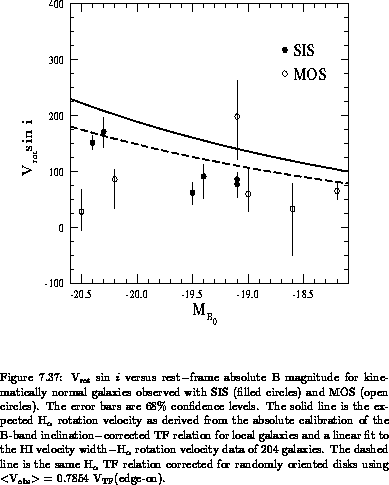 Fisher relation, we used galaxies satisfying the following two selection criteria: (1) a difference between the position angle of the slitlet and the position angle of the major axis of the galaxy less than 45
Fisher relation, we used galaxies satisfying the following two selection criteria: (1) a difference between the position angle of the slitlet and the position angle of the major axis of the galaxy less than 45 , and (2) consistent [OII] and broad-band scale lengths. Criterion (1) was applied only to the MOS data, since a misalignment between the major axis of a galaxy and the position angle of the slitlet artificially decreases the magnitude of V
, and (2) consistent [OII] and broad-band scale lengths. Criterion (1) was applied only to the MOS data, since a misalignment between the major axis of a galaxy and the position angle of the slitlet artificially decreases the magnitude of V sin
sin  . Figure
. Figure  sin
sin  versus k
versus k corrected absolute B magnitude for the 12 remaining kinematically ``normal'' galaxies. V
corrected absolute B magnitude for the 12 remaining kinematically ``normal'' galaxies. V sin
sin  's and B magnitudes were taken from Tables
's and B magnitudes were taken from Tables  rotation velocity as derived from the absolute calibration of the B-band inclination
rotation velocity as derived from the absolute calibration of the B-band inclination rotation velocity data of 204 galaxies
rotation velocity data of 204 galaxies  TF relation expected for randomly oriented disks (dashed line) based on the fact that <V
TF relation expected for randomly oriented disks (dashed line) based on the fact that <V > = 0.7854 <V
> = 0.7854 <V > for randomly oriented disks.
> for randomly oriented disks.
